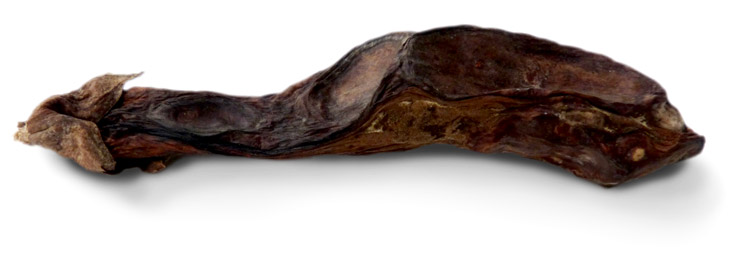Evaporated Eggplant
Solanum melongena
Donated by Andrew Ortolano and Sarah Waxman
2017
Weight: 6 g
Length: 15.5 cm

When Andrew Ortolano brought this eggplant to his apartment from the grocery store, he was most likely not thinking about plasmolysis, turgor pressure, or the collapse of cell walls. He was not thinking about the fact that 92 percent of an eggplant is water. He just set his eggplant on his kitchen windowsill, thinking that he would cook it in the near future. But he wasn’t spending much time in his apartment, and there on the windowsill the eggplant remained. Inadvertently, he allowed the aforementioned biological processes to occur in his eggplant.
Plant cells store surplus water in compartments called vacuoles, which swell and apply pressure on the cell walls. This is called turgor pressure and is what gives a plant its rigidity and structure. As soon as a vegetable is picked, its moisture begins to evaporate. As the vegetable continues to lose moisture, it taps into its reserves, drawing the water from its vacuoles through osmosis. The turgor pressure decreases, causing the vacuoles to shrink and the cell walls to collapse (a phenomenon called plasmolysis).
As this eggplant sat and sat, its vast water content diminished, leaving only an incredibly lightweight, diminutive version of its former self. Note that although this specimen resembles a slender Japanese eggplant, it started as a sizable, robust, round purple eggplant.
Ortolano no longer lives alone, and jointly with his partner, he has generously donated this unusual specimen. In the future, may they be ever vigilant over their communal produce. NEXT >